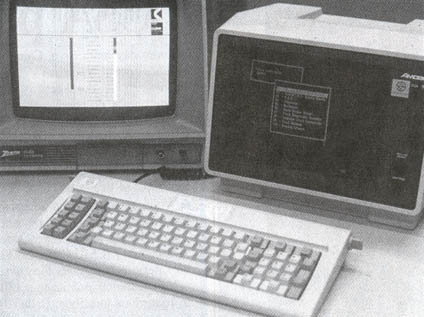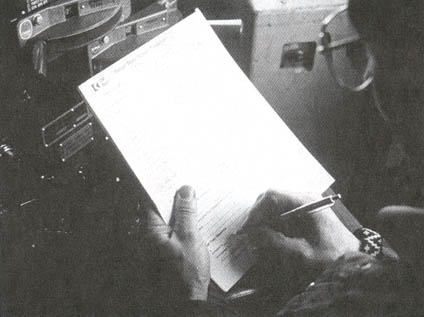Vol. 17 No. 5
May, 1987
|
Stay Safe in 87
|
|
CP Rail Takes First Major Step Toward Advanced Train
Control
By Steve Morris

The computer acts like a partner or co-worker
to the dispatcher under the CMBS system.
Calgary - In a decade or so, freight trains will still
look much the same as they do today. There'll still be diesel-electric locomotives and freight cars
rolling along on steel rails. But, as they say in the automobile industry, "it's what's under the hood that
counts".
In this case, "under the hood" means computer-assisted operations. And CP Rail already has
taken the first major step toward developing the railway of the future with its Computerized Manual Block System
(CMBS).
CMBS is part of a new method of train operation management known internationally as Advanced Train Control Systems
(ATCS). It uses computers to guide trains and monitor a variety of locomotive functions and track conditions.
CP Rail's transportation development group, headquartered in Calgary, has been developing the system since 1982 as
part of a long-range research and development program geared to significantly improving train operation
technology and methods.
Jim Geddis, vice-president, transportation development, sees the project as an important step toward
advanced train control before the mid-1990s.
CHALLENGE
"What started as an idea a few years ago has progressed beyond the drawing board and become an intriguing
challenge for the transportation team. With CMBS, we are implementing a system of train movement authority that CP
Rail pioneered. And that's a rewarding experience," Mr. Geddis said.
CP Rail, in co-operation with most North American railways, the Railway Association of Canada, and the
Association of American Railroads, is working on ATCS, which involves a four-tier program of research
and development.
CMBS represents the beginning of ATCS - termed "Level 10". This level is currently in place on more than
97 percent of CP Rail's territory not governed by Centralized Traffic Control (CTC).
Level 10 means that a dispatcher can use a computer terminal to safely control all types of railway operations over
any given territory. CMBS replaces the old control system which involved written train orders and bulletins that
traditionally controlled operations on both CTC and non-CTC territory.
The computer is programmed with track profiles and all other relevant information concerning trains and the
territory over which they operate.
Before a train is allowed to enter a dispatcher's territory, the dispatcher and train crew are required to complete a
manual block system clearance form. Much like an airline pilot's checklist, the form includes information such as the
train's departure and arrival points, when crews should check in with dispatchers, what bulletins or slow orders are
in effect, and what other trains are in the area.
In the dispatch office, the form is displayed on a computer screen. Using the information, along with the previously
programmed track profiles, the computer can guide the dispatcher and train crew through any given train authority.
SAFETY FEATURE
A train's conductor and locomotive engineer augment the system with information transmitted by radio to the
dispatcher.
The system's major safety feature is that it does not permit a dispatcher to issue any directive that conflicts with
another authority. This increases safety because it prevents the dispatcher from authorizing other trains from
entering a train's territory.
Once the dispatcher and train crew have completed the clearance form or, in the case of track workers, a track
occupancy permit, all instructions are repeated word for word, line for line to the dispatcher. As this procedure is
being done, the dispatcher, using the space bar on his computer keyboard, verifies each word or number by underlining
them on his screen.
Once the crew has repeated and acknowledged receipt of the clearance and/or train authority from the dispatcher, the
dispatcher pushes a key which confirms to the computer that the crew has permission to proceed and logs the
information in the computer's memory.
"Because the dispatcher usually has many trains to look after as well as a host of other duties, the computer is
acting like a partner or co-worker," Mr. Geddis said.
If for some reason - such as an emergency - the dispatcher is distracted and later returns to his computer and tries
to issue a movement authority that conflicts with one already in the system, his "partner" says
"sorry, you can't do that".
The CMBS system had to be adapted to the Uniform Code of Operating Rules (U.C.O.R.), which governs safe train
operations in Canada, he said, adding the system had to take into consideration every conceivable operating
situation.
FAIL SAFE
"We had to keep modifying CMBS until everyone was satisfied it was fail safe," said Mr. Geddis.
"Because we were breaking new ground, it kept many of the staff burning more than one night's worth of midnight
oil.".
The computer has a wealth of additional information to assist despatchers including train locations, yard layouts,
switch locations and positions - even crew member's names.
As with any new system, training and adjustment periods are required. Terry Edwards, who has worked for 13 years for
CP Rail in Alberta, is one of several trainers helping employees through the basics of the new
CMBS-Level 10 system.
"When we started out on the system a year and a half ago, I didn't think it could do everything they said it
could. but I don't think that way now," Mr. Edwards said.
"The system can do yard searches, tracing, and a host of other functions that in the past meant we had to leave
our posts and go searching for the information elsewhere in the office."
In addition to preventing conflicting movement authorities, CMBS also enhances railway safety in other ways.
"With CMBS-Level 10, there is less of a fatigue factor, which means we are as alert at the end of
a shift as we were when we started," Mr. Edwards said.
Another added advantage is the system's power source which cannot be interrupted should there be a power failure.
With this emergency power system, the main computer and desk-top units can operate for three days
without general power. The system also is protected from power surges or drops.
"This was a vital safety feature we knew had to be built in from the start," Mr. Geddis said. "We
couldn't risk losing the computer's memory for a split second. That would defeat the purpose of the system."
The current CMBS system is but the trail-blazer for future operating enhancements that will become
possible with higher levels of ATCS.
Transportation Development already is working on the next step with a special project in Didsbury, Alberta, about
100 kilometres north of Calgary. This project involves two GP-38 locomotives equipped with sophisticated
equipment capable of controlling train speeds and track switches.
The 2,000-horsepower locomotives have been running daily between Didsbury and Crossfield on the main
line between Calgary and Edmonton since November, 1986.
Each locomotive is equipped with a different supplier's components. The systems enable the train crew to align power
switches and by remote control provide information in advance of setting hand-controlled switches.
"This is only the beginning," Mr. Geddis said. "The next few years at CP Rail are going to be more
than just exciting. The whole North American railway industry is keeping a close eye on what we're doing
here."

Locomotive engineers such as Lee Sallenback fill out a key element of the
CMBS-Level 10 system - the pre-printed Manual Block Clearance Form.
This CP Rail News article is copyright
1987 by the Canadian Pacific Railway and is reprinted here with
their permission. All photographs, logos, and trademarks are the property of the Canadian Pacific Railway
Company.
|